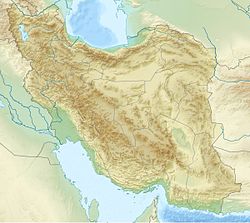| Jāmeh Mosque of Zanjān | |
|---|---|
مسجد جامع زنجان | |
 | |
| Religion | |
| Affiliation | Shia Islam |
| Ecclesiastical or organizational status | Friday mosque and madrasa |
| Status | Active |
| Location | |
| Location | Zanjān, Zanjān county, Zanjān Province |
| Country | Iran |
Location of the mosque in Iran | |
| Geographic coordinates | 36°40′5″N 48°28′56″E / 36.66806°N 48.48222°E |
| Architecture | |
| Type | Mosque architecture |
| Style | Qajar |
| Completed | 1826 CE |
| Specifications | |
| Dome(s) | One (maybe more) |
| Minaret(s) | One (destroyed in 1959) |
| Official name | Jāmeh Mosque of Zanjan |
| Type | Built |
| Designated | 30 April 1963 |
| Reference no. | 1056 |
| Conservation organization | Cultural Heritage, Handicrafts and Tourism Organization of Iran |
The Jāmeh Mosque of Zanjān (Persian: مسجد جامع زنجان, romanized: Masjid-e-Jāmeh Zanjān; Arabic: جامع زنجان), also known as the Seyyed Mosque (Persian: مسجد سید, romanized: Masjid-e-Seyyed) and the Sultani Mosque, is a Shi'ite Friday mosque (jāmeh) and madrasa, located in the city of Zanjān, Zanjān county, in the province of Zanjān, Iran.[1] The mosque is situated in the old part of the city and was constructed in 1826 CE, during the Qajar era.[2]
The mosque was added to the Iran National Heritage List on 30 April 1963, administered by the Cultural Heritage, Handicrafts and Tourism Organization of Iran.
Architecture
[edit]The mosque and school was built in the 17th century AH (1242 CE)[clarification needed] during the Qajar era, it was initially named the Seyyed Mosque.[1] The construction was carried out by Abdollah Mirza who was one of the children of Fat'h 'Alī Shāh Qājār.[2] It is located near the Zanjan bazaar.[3] The mosque had a minaret that was destroyed in 1959 CE.
To the east and west of the sahn are sixteen chambers that are parallel to each other. Facing towards south are rise chambers used as residential quarters for theology students. The ceilings of these chambers being artistically decorated with diagonal arches that are 5 metres (16 ft) from the floor. The portions have beautifully vaulted and have arched ceilings. The chambers have also been worked in tile dating back to Qajar era. The mosque has three places for nocturnal payers, or Shabestan, each having an altar. The dome of this mosque is spectacular. The mosque contains four iwans on the sides of a large open court. The residential chambers have vaulted and arched ceilings decorated with artistic tile work.[2]
Gallery
[edit]See also
[edit]References
[edit]- ^ a b Mahmoudi, Amir Ali. "مسجد جامع زنجان" [Zanjan Grand Mosque]. Kojaro (in Persian).
- ^ a b c "Zanjan Jame' (Seyed) Mosque". Iran Tourism and Touring Organization. 4 June 2008. Retrieved 4 June 2008.
- ^ مسجد جامع زنجان (مسجد سيد) [Zanjan Grand Mosque (Sayed Mosque)]. VisitIran.ir (in Persian). Retrieved 16 November 2023.
External links
[edit]![]() Media related to Jameh Mosque of Zanjan at Wikimedia Commons
Media related to Jameh Mosque of Zanjan at Wikimedia Commons


 Français
Français Italiano
Italiano










